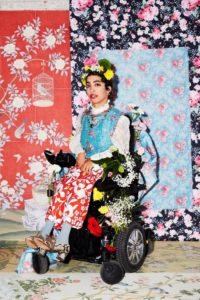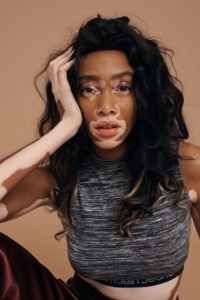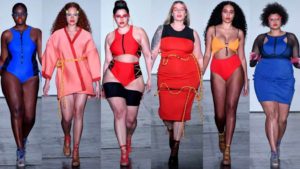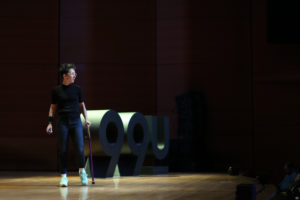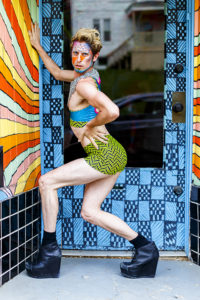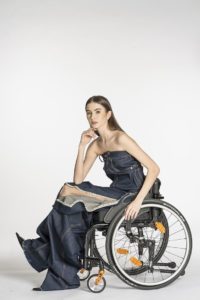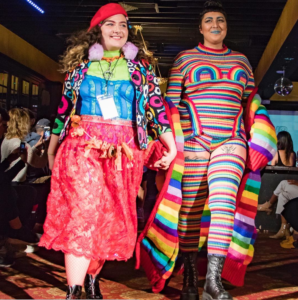
Phone: 212 520 1686
Email: info@yourcpf.org
7 Fashion Designers That Are Breaking The Mold
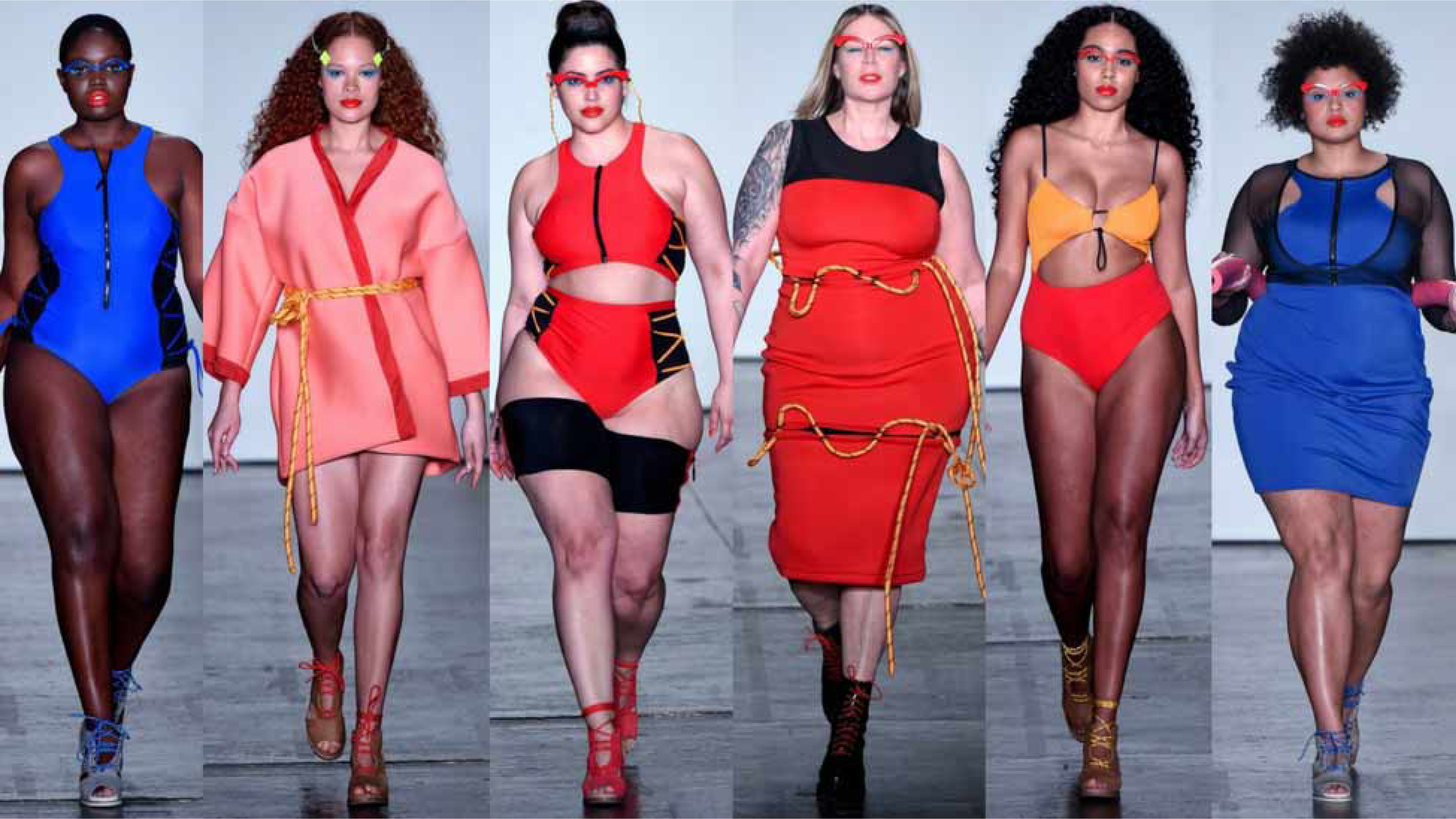
Written By: Jessy Yates
I am a wobbly walker. I barely skim five feet tall. I have crooked teeth and temperamental skin. I use a wheelchair and have untoned legs.
Somedays I feel like the only place for people like me in the beauty and fashion world is on the on the “before” section of “before and after” makeover pages. There are multimillion dollar industries that make normal people look less like themselves based on arbitrary standards that seem to be decreed from on high. Judging from ads and media, it would seem that people with differing bodies from the tall, abled, white, cisgendered models don’t exist. It’s remarkable tough to remember who you are when billion dollar industries are telling you that you don’t or shouldn’t exist. These images insert themselves into surprising facets of our culture until we wake up with the first thoughts in the morning are how you can use the new day to fix something about you image, rather than using that day for work, joy, and emotional connection.
Being part of the disabled community also comes with frustrations about our image and self-worth. People tell us to our faces that they would prefer to be dead, than disabled. We are told from medical communities that we should be looking for cures at every turn. Recently, an amazing video of Cerebral Palsy Foundation’s Design for Disability Annual Fashion Show surfaced on Instagram. However, the comments (I know, I know, never the comments section…) seemed to question our beautiful models’ right to a place in fashion, design, and beauty–even in an event specifically focusing on design with disability in mind. It seems we have a long way to go to changing perspectives of who and what is considered beautiful.
But fashion ideals are rapidly changing. Diversity is selling fast and soon the days of model as blank canvas are being left in the dust. Designers are investing more deeply into community and diverse models are breaking boundaries left and right. It seems even old fashion houses that have previously been set their aesthetic are slowly beginning to change their habitual ways. We have compiled a list of movers and shakers that are changing the fashion and design game. Theses are some of my biggest role models that I look to when I feel frustrated about living in a world not made for people who exist in bodies outside the norm.
Wheelchair using model Jillian Mercado began modeling when she scored a national Diesel campaign in 2014. Since rising to model fame, she has been public about being a proud Latina, Disabled women. However, recently she has begun to use her voice to disability advocacy. In a recent interview the Ministry of Ideas she said, “If you want to know what you can do in your workplace to expand the knowledge of accessibility? Hire, hire, hire. Hire people who have disabilities and you won’t have to ask these questions.” We cannot wait to hear about her more as she expands into voicing her her thoughts on disability rights.
Supermodel with vitiligo, Winnie Harlow, has modeled for major international campaigns for Desigual, Sprite, and Swarovski and has been seen in editorial shoots for Vogue Italia, Dazed, i-D, and Complex. In an interview with Teen Vogue she said “Today I represent a different standard of what people traditionally consider beauty.” She is a part of a change that celebrates all bodies.
3. Chromat
We can’t talk about fashion houses that are at the forefront of pushing diversity during fashion week than make-up and bathing suite design house, Chromat. In the past two New York Fashion Weeks they have included models with prosthetic limbs, countless plus-sized models, and several transgender models. In a review of Chromat’s year, Vogue wrote “Chromat offers something different—a glimpse of real women in all their glory, actively making fashion more interesting.”
4. Liz Jackson
Liz Jackson, a disabled designer, curator, and all-together bad a** is demolishing the rules for accessible design and making a trail of improvements and seismic shifts in her path. She has started The Disabled List, a self-advocacy collective of disabled designers fighting for employment, training, and mentorship opportunities for disabled artists and designers. She has astutely noticed that many brands that market “accessible fashion” and “disability design” are devised without disabled employees involved. In my go-to, most quoted, favorite recent article from Motherboard, she was quoted in saying ‘“There’s not a single company that has invited disability to the table…Nobody…It still hasn’t occurred to people that disabled people are the experts in disability.” She in an expert in examining the intricacies of accessible design to optimize agency for disabled individuals and will rightfully call out companies that claim accessibility without employing disabled creators. I can’t quite make a summation of all of Liz’s work in a small paragraph, so I encourage you to look for yourself.
Inclusion is at the core of this independent designers work–in fact, radical representation for all bodies is the crux of their mission. Self-proclaimed “queer-crip” designer, Sky Cubacub, makes brightly colored, accessible, and edgy stretch wear that encourages the wearer to stand out and celebrate their diversities. Self-produced and run, Sky has made a name for themselves by designing for 10 year old drag-wonderkid–Desmond Is Amazing, RuPaul’s Drag Races Season 10 competitor– Vixen, and Brit singer Kate Nash (and yours truly…). As it stands, they’re one to watch and the neon makes ‘em hard to miss.
A new comer in the fashion world, wheelchair using designer, Louise Linderoth, is cooking up the most fashion forward accessible-seated jeans I’ve yet to see. Recently partnered with Dr Denim, Linderoth has revolutionized the shape of the traditional jean. She has taken her experiences as wheelchair user and lover of denim to a revolutionary place, proving Liz Jackson right–disabled individuals are the best experts in disability.
Recent FIT graduate, Grace Insogna, has been radically inclusive since she started. In 2016, Insogna participated in CPF’s first Design for Disability gala (and won) and I have been obsessed with her and her creations ever since. This year she made history by being the first student to send a plus size model down the FIT Senior Fashion Show runway. Since graduating in may, she has launched a personal brand that has won praises from pop celeb, Lizzo. Additionally, her designs have been strongly pointed and has made garments that break the stigma of mental illness. In her Nylon interview she said “We can’t necessarily control how other people view us or what they say about us, but we can definitely change our internal narrative and shift it to one that’s more compassionate.” I couldn’t agree more!
I look to the people above when I waver, when I feel like everything about myself is wrong. I see other’s defying the odds in an industry that is unimaginably difficult and I remind myself that every body is a good body, because they’re the only one’s we got. And my heroes above are reminding the world of that.





